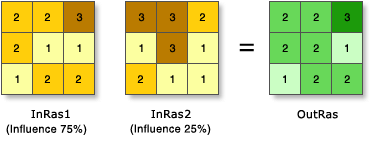Available with Spatial Analyst license.
Summary
Overlays several rasters using a common measurement scale and weights each according to its importance.
Illustration

Usage
All input rasters must be integer. A floating-point raster must first be converted to an integer raster before it can be used in Weighted Overlay. The Reclassification tools provide an effective way to do the conversion.
Each value class in an input raster is assigned a new value based on an evaluation scale. These new values are reclassifications of the original input raster values. A restricted value is used for areas you want to exclude from the analysis.
Each input raster is weighted according to its importance or its percent influence. The weight is a relative percentage, and the sum of the percent influence weights must equal 100. Influences are specified by integer values only. Decimal values are rounded down to the nearest integer.
Changing the evaluation scales or the percentage influences can change the results of the weighted overlay analysis.
By default, this tool will take advantage of multicore processors. The maximum number of cores that can be used is four.
To use fewer cores, use the parallelProcessingFactor environment setting.
See Analysis environments and Spatial Analyst for additional details on the geoprocessing environments that apply to this tool.
Syntax
WeightedOverlay(in_weighted_overlay_table)
| Parameter | Explanation | Data Type |
in_weighted_overlay_table | The Weighted Overlay tool allows the calculation of a multiple-criteria analysis between several rasters. An Overlay class is used to define the table. The WOTable object is used to specify the criteria rasters and their respective properties. The form of the object is:
| WOTable |
Return Value
| Name | Explanation | Data Type |
| out_raster | The output weighted raster. | Raster |
Code sample
This example creates a suitability IMG raster that identifies potential site locations for a ski area.
import arcpy
from arcpy import env
from arcpy.sa import *
env.workspace = "C:/sapyexamples/data"
outsuit = WeightedOverlay(WOTable(
[
["snow", 50, 'VALUE', RemapValue([[1,"Nodata"],[5,3],[9,10],["NODATA","NODATA"]])],
["land", 20, '', RemapValue([["water","1"],["forest",5],["open field",9],["NODATA", "NODATA"]])],
["soil", 30, 'VALUE', RemapValue([[1,"Restricted"],[5,5],[7,7],[9,9],["NODATA", "Restricted"]])]
],[1,9,1]))
outsuit.save("C:/sapyexamples/output/outsuit.img")This example creates a suitability IMG raster that identifies potential site locations for a ski area.
# Name: WeightedOverlay_Ex_02.py
# Description: Overlays several rasters using a common scale and weighing
# each according to its importance.
# Requirements: Spatial Analyst Extension
# Import system modules
import arcpy
from arcpy import env
from arcpy.sa import *
# Set environment settings
env.workspace = "C:/sapyexamples/data"
# Set local variables
inRaster1 = "snow"
inRaster2 = "land"
inRaster3 = "soil"
remapsnow = RemapValue([[0,1],[1,1],[5,5],[9,9],["NODATA","NODATA"]])
remapland = RemapValue([[1,1],[5,5],[6,6],[7,7],[8,8],[9,9],["NODATA","Restricted"]])
remapsoil = RemapValue([[0,1],[1,1],[5,5],[6,6],[7,7],[8,8],[9,9],["NODATA", "NODATA"]])
myWOTable = WOTable([[inRaster1, 50, "VALUE", remapsnow],
[inRaster2, 20, "VALUE", remapland],
[inRaster3, 30, "VALUE", remapsoil]
], [1, 9, 1])
# Execute WeightedOverlay
outWeightedOverlay = WeightedOverlay(myWOTable)
# Save the output
outWeightedOverlay.save("C:/sapyexamples/output/weightover2")Environments
Licensing information
- Basic: Requires Spatial Analyst
- Standard: Requires Spatial Analyst
- Advanced: Requires Spatial Analyst